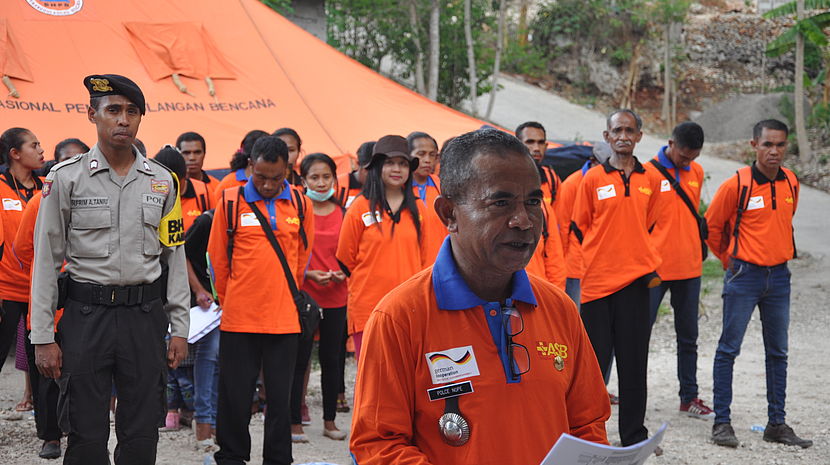Inclusive Approaches to Disaster Risk Reduction and Humanitarian Action

Polce, the village head of Kuatae, with the local Disaster Risk Reduction team during a simulation in Indonesia.
© ASB
CBM alongside other international organisations is part of a project that puts persons with disabilities at the centre of humanitarian preparedness and response. With this project we hope to build and strengthen capacity in inclusive humanitarian action and inclusive disaster preparedness through the active inclusion of persons with disabilities.
Why do we need this project?
Disasters do not affect all people equally. Persons with disabilities and other at-risk groups are often forgotten in disaster preparedness and left behind when disaster strikes. They are too often excluded from preparedness activities, and invisible when it comes to community and risk mapping or evacuation planning. Moreover, once evacuated, persons with disabilities may have a difficult time accessing shelters and safe spaces because of environmental, institutional and attitudinal barriers they may face. Overall, persons with disabilities are a lot more likely to be exposed to disproportionate risks and to receive insufficient or inappropriate assistance and support in times of crisis.
Stakeholders and vision of project
Along with CBM, the project is jointly implemented by Arbeiter-Samariter-Bund (ASB), Malteser International (MI), and Centre for Disability in Development (CDD) as well as the International Disability Alliance (IDA). With a total budget of almost 3.2 million euros funded by the German Federal Foreign Office, the project will run till Dec 2023.
The vision of the project is to foster inclusive approaches to disaster risk reduction and humanitarian action. It brings together key actors from the international to the community level to generate and exchange knowledge, develop capacity and explore best practices. At the global level, the project will encourage collaboration amongst key actors to promote and advance the inclusive disaster risk reduction agenda and to position it at the centre of international debate. It will produce a research study on the status quo of implementation of SFDRR inclusion commitments and develop a training curriculum to support the inclusive implementation of the Sendai framework at international and national level.
Implementation in disaster-prone countries
The project will be implemented in particularly disaster-prone countries on the African continent (Niger, Zimbabwe, Uganda), Asia (Bangladesh, Indonesia, Myanmar), and South/Central America (Colombia, Nicaragua). The objective is to foster exchange and to strengthen the capacity of national and local governmental and non-governmental actors to best work towards and engage in inclusive disaster risk reduction measures. Moreover, the project intends to pilot promising and innovative approaches at the community level generating best practice and lessons learned.